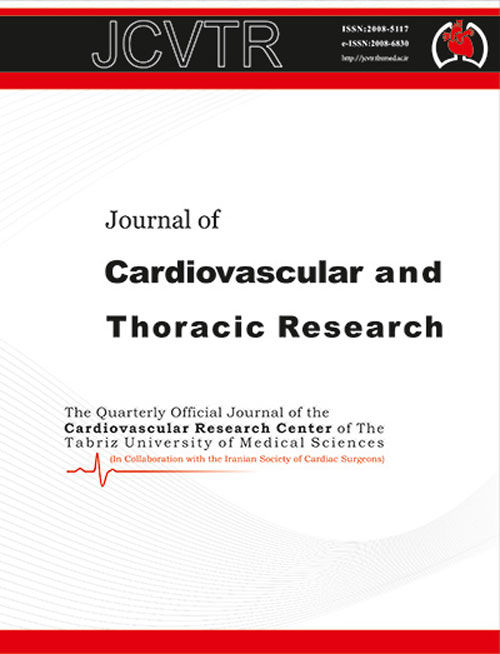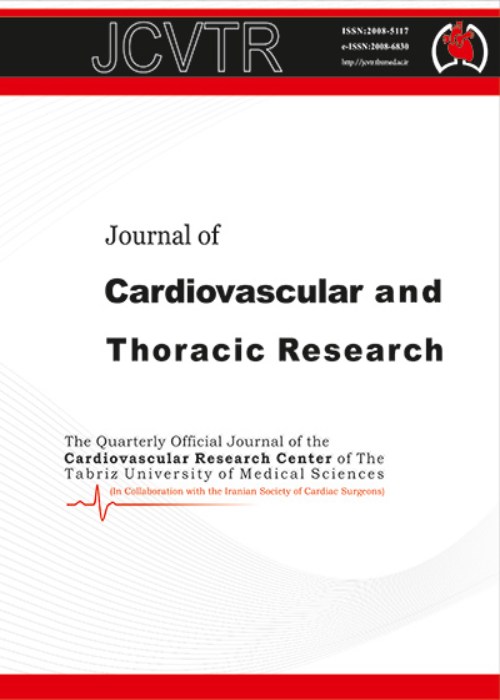فهرست مطالب

Journal of Cardiovascular and Thoracic Research
Volume:8 Issue: 2, Jun 2016
- تاریخ انتشار: 1395/04/24
- تعداد عناوین: 10
-
-
Pages 49-55Transcatheter aortic valve replacement (TAVR) is rapidly gaining popularity as a viable option in the management of patients with symptomatic aortic stenosis (AS) and high risk for open surgical intervention. TAVR soon expanding its indications from "high-risk" group of patients to those with "intermediate-risk". As an anesthesiologist; understanding the procedure and the challenges inherent to it is of utmost importance, in order to implement optimal care for this generally frail population undergoing a rather novel procedure. Cardiac anesthesiologists generally play a pivotal role in the perioperative care of the patients, and therefore they should be fully familiar with the circumstances occurring surrounding the procedure. Along with increasing experience and technical developments for TAVR, the procedure time becomes shorter. Due to this improvement in the procedure time, more and more anesthesiologists feel comfortable in using monitored anesthesia care with moderate sedation for patients undergoing TAVR. A number of complications could arise during the procedure needing rapid diagnoses and occasionally conversion to general anesthesia. This review focuses on the periprocedural anesthetic considerations for TAVR.Keywords: Aortic Valve Stenosis, TAVR, General Anesthesia
-
Pages 56-60IntroductionInvestigating the clinical impact of serum uric acid (UA) and its lowering agents on the complications and mortality of acute ST-elevation myocardial infarction (STEMI) can open a new era in STEMI treatment. The aim of this study was to evaluate the effect of on admission serum UA level on the mortality and morbidity of patients admitted with STEMI.MethodsA number of 608 patients with STEMI were enrolled in this study from December 21, 2012 until February 19, 2014. Patients were followed for 20 months. Male to female ratio was 2.53, and the mean age of patients was 62.6±13.4. The relationship between the level of UA and patients mortality and morbidity, left ventricular ejection fraction (LVEF), atrial and ventricular arrhythmia was analyzed.ResultsPatients with high serum UA level had higher Killip class after STEMI (P = 0.001). Mean LVEF was measured to be 39.5 ± 9.6 in normal UA group and 34.6 ± 11.6 in high UA group (P = 0.001). In comparison with normal UA group, high UA group had significantly higher cTnI (2.68 ± 0.09 vs 4.09 ± 0.42, respectively, P = 0.001), increased blood pressure (P = 0.009), and higher atrial fibrillation (AF) occurrence (P = 0.03), but no association was seen between ventricular tachycardia and serum UA level. Short term and midterm mortality were not different in two groups (P = 0.44 and 0.31, respectively).ConclusionIn the current study, high serum UA level in patients with acute myocardial infarction (MI) was not associated with higher in-hospital or midterm mortality, but it was associated with lower LVEF, higher Killip class, elevated cTnI, creatinine, triglyceride, and higher AF.Keywords: Acute Myocardial Infarction, Serum Uric Acid, Left Ventricular Systolic Dysfunction, Cardiac Troponin I
-
Pages 61-64IntroductionIt is thought that pituitary-adrenal axis has a fundamental role in outcome of cardiopulmonary arrest (CPA). This study designed to evaluate the correlation between adrenal reserve and post-resuscitation outcome.MethodsIn this clinical trial study, 52 consecutive patients with CPA were enrolled in two emergency departments (EDs) over a 3-month period. Plasma cortisol level was measured at the beginning of CPR. Intravenous adrenocorticotropic hormone (ACTH) stimulation test was carried out after successful CPR, and blood samples were taken at 30 and 60 minutes, and 24 hours thereafter. Patients were divided into two groups: in-hospital death or hospital discharge.ResultsIn patients who died, baseline and post-ACTH serum cortisol after 30 and 60 minutes and 24 hours were higher than patients who discharged from the hospital, but it was not statistically significant except to that of minute 60 (P = 0.49). A model of multivariate logistic regression analysis showed that age and need for vasopressor infusion correlated with mortality.ConclusionCurrent study could not show the statistically significant difference in initial and post-ACTH serum cortisol levels between survivor and non-survivor patients with cardiac arrest who had initial successful CPR, except to that of minute 60.Keywords: Cardiopulmonary Arrest, Cardiopulmonary Resuscitation, Adrenal Insufficiency, Return of Spontaneous Circulation, Cortisol Level, Pituitary, Adrenal Axis
-
Pages 65-71IntroductionReperfusion injury is a well-known phenomenon following restoration of the coronary circulation after coronary artery bypass grafting (CABG) that impairs myocardial function. In order to control the severity of this injury, we aimed to investigate the effect of a new conditioning strategy namely ischemic postconditioning (IPOC) along with controlled aortic root reperfusion (CARR) on myocardial protection in CABG surgery with cardiopulmonary bypass.MethodsIn a doubled blind clinical trial study, 51 patients undergoing first-time elective CABG were randomly divided in three groups: CARR, IPOC, and combination of IPOC and CARR. At the end of procedure and just before aortic cross-clamp removal, reperfusion was started as following: In CARR-receiving groups, the reperfusion was started with low perfusion pressures for 10 minutes, and in IPOC-receiving groups, three cycles of 1 minute episodes of ischemia separated by 1 minute episodes of reperfusion was applied as postconditioning protocol. Left ventricular ejection fraction (EF) (by echocardiography), inotrope requirement index, and myocardial arrhythmias were measured up to 72 hours after operation.ResultsEchocardiography revealed that the recovery of EF after operation in IPOC group was significantly higher than those of two other groups (PConclusionThe study suggests that IPOC may provide clinical benefits against reperfusion injury in patients undergoing CABG surgery and maintain the post ischemic left ventricular performance.Keywords: Ischemic Postconditioning, Coronary Artery Bypass Grafting, Reperfusion Injury
-
Pages 72-76IntroductionStandards have a significant role in showing the minimum level of optimal optimum and the expected performance. Since the perfusion technology staffs play an the leading role in providing the quality services to the patients undergoing open heart surgery with cardiopulmonary bypass machine, this study aimed to assess the standards on how Iranian perfusion technology staffs evaluate and manage the patients during the cardiopulmonary bypass process and compare their practice with the recommended standards by American Society of Extracorporeal Technology.MethodsIn this descriptive study, data was collected from 48 Iranian public hospitals and educational health centers through a researcher-created questionnaire. The data collection questionnaire assessed the standards which are recommended by American Society of Extracorporeal Technology.ResultsFindings showed that appropriate measurements were carried out by the perfusion technology staffs to prevent the hemodilution and avoid the blood transfusion and unnecessary blood products, determine the initial dose of heparin based on one of the proposed methods, monitor the anticoagulants based on ACT measurement, and determine the additional doses of heparin during the cardiopulmonary bypass based on ACT or protamine titration. It was done only in 4.2% of hospitals and health centers.ConclusionCurrent practices of cardiopulmonary perfusion technology in Iran are inappropriate based on the standards of American Society of Cardiovascular Perfusion. This represents the necessity of authorities attention to the validation programs and development of the caring standards on one hand and continuous assessment of using these standards on the other hand.Keywords: Perfusion, Standard, Cardiopulmonary bypas
-
Pages 77-82IntroductionCardiac catheterization procedure through the trans-radial access (TRA) have shown many clinical advantages over the trans-femoral (TFA), but despite its advantages, there are serious concerns regarding higher possible radiation dose for the patients and operators in TRA. This study was planned to compare the patients radiation dose associated with TRA and TFA during coronary angiography (CA) and percutaneous transluminal coronary angioplasty (PTCA).MethodsOf 700 candidates for angiography, 326 patients were entered the study. All the procedures were carried out by one interventional cardiologist employing the same angiography unit in Aalinasab hospital and the patients dose area product (DAP), air kerma (AK), fluoroscopy time (FT) and cine film time (CFT) were then determined in both access groups (TRA,TFA) in CA, PTCA and CA㴰 procedures.ResultsThe mean FT, CFT and AK values in both TRA & TFA groups were the same in all procedures (P > 0.05). The mean DAP in CA㴰 procedures was 6704.01 ± 3243.23 µGym2 in femoral access compare with 5647.46 ± 2797.74 µGym2 in radial access, which were significantly less than that in TFA with P = 0.02.ConclusionOn the basis of the results obtained in this study, no differences were found in patients radiation dose in both access groups, therefore with regard to comparatively more clinical advantages associated with the Trans-radial access technique it might be a good substitute for Trans-femoral access.Keywords: Tran Radial Access (TRA), Trans Femoral Access (TFA), Patient Radiation Dose
-
Pages 83-85Introductionβ2agonists are first election drugs for the treatment of respiratory disease that may alter cardiac autonomic modulation. The aim of this study was to evaluate the effects of nebulized Ventolin on electrocardiogram, particularly QTc interval to assess the potential arrhythmogenic risks.MethodsA total of 192 patients between 2 months and 15 years which received nebulized Ventolin were enrolled in this study. Patients were divided into two groups. Electrocardiograms of patients before and after nebulized Ventolin were taken. Differences between two groups were assessed using a paired students t test.ResultsThere was statistically significant differences in QTc before and after Ventolin in each groups (PConclusionAlthough Ventolin can cause changes in QTc, Ventolin with 0.15 mg/kg/dose in comparison with 0.1 mg/kg/dose does not cause significant changes in QTc.Keywords: Ventolin, Electrocardiogram, Children
-
Pages 86-87We present a case of simultaneous coronary thrombosis of the left main, the left anterior descending artery and the right coronary artery in a patient, recently diagnosed with rheumatoid arthritis.Keywords: Rheumatoid arthritis, Methotrexate, Coronary thrombosis
-
Pages 88-90Due to long term patency, the internal mammary artery is considered as a conduit of choice for revascularization of the left anterior descending coronary artery. The internal mammary artery and its accessory branches in addition to perfusing the chest wall structures also contributes to supplying, part of the female breast arteries. In addition, due to the accompaniment of thoracic duct branches with the left internal mammary artery, harvesting may be associated with injury to these branches and contribute to chylothorax. We report a rare case of chylothorax and the breast necrosis following the coronary artery bypass grafting. The chylothorax was started in the second postoperative day and ceased gradually in the 12th day of operation. The breast necrosis appeared in the 3th weeks of operation with pain, and tenderness and black skin color change. The patient underwent total mastectomy in the 4th weeks of operation.Keywords: Coronary Artery Bypass Grafting, Complication, Breast Necrosis
-
Page 91


